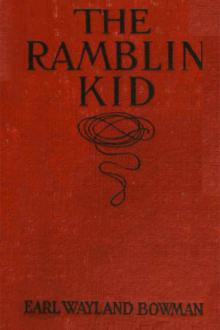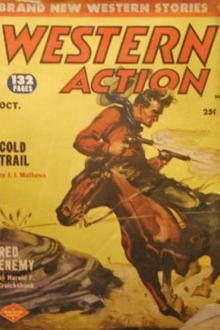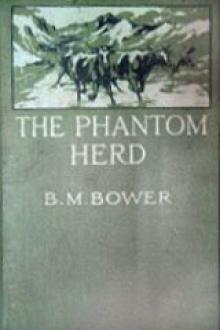Spinifex and Sand<br />A Narrative of Five Years' Pioneering and Exploration in Western Ausralia, David Wynford Carnegie [best novels in english .txt] 📗

- Author: David Wynford Carnegie
Book online «Spinifex and Sand<br />A Narrative of Five Years' Pioneering and Exploration in Western Ausralia, David Wynford Carnegie [best novels in english .txt] 📗». Author David Wynford Carnegie
What chance has one of finding water, except by the most diligent search and by making use of every sign and indication written on the surface of the ground? This well was similar to the one already described, excepting in one important respect. This one had water. Turning the camels out we started work, and by sundown had the well in order. Tying the others down we proceeded to water each camel in turn. Picture our surprise and joy when each turned from the bucket without drinking more than two gallons. Billy rolled up like a great balloon, and one would have sworn that he had just had a long drink. What was this miracle? Here were camels, after an eight days' drought, travelling eight to ten hours daily in hot weather, over rough stones and gravel, actually turning away from water!
The answer to this riddle was “Parakeelia.” This is a local, presumably native, name in Central Australia for a most wonderful and useful plant. A specimen brought back by me from this locality was identified at Kew as Calandrinia balonensis. This plant grows close to the ground in little bunches; in place of leaves it has long, fleshy projections, like fingers, of a yellowish-green colour. From the centre grows a pretty little lilac flower at the end of a single thin stalk. The fingers are full of watery juice and by no means unpalatable. We tried them raw, and also fried in butter, when they were quite good eating. The plant is greedily devoured by stock of all kinds, and in dry tracts in Central Australia has been the means of saving many head of cattle. As we found it, it was not easily got hold of, for invariably it grew right in the centre of a hummock of spinifex. At first the camels, not knowing its properties, would not risk pricking themselves, but after we had shown them, by clearing away the spinifex, how nice it was, they did not hesitate to plunge their soft noses into the spiny mass, with what good effect I have already described. Indeed, this plant is a wonderful provision of nature, and compensates a little for the hideous sterility of the country. I am not wide of the mark when I say that given “parakeelia” every second night or so a camel would never want to drink at all, though it is not really as serviceable as water—not having the same lasting effect. A similar plant, also found in Central Australia, is “Munyeru.” In the centre of this a little bag of black seeds grows; these seeds are crushed and eaten by the natives. Munyeru, Breaden tells me, is quite a good vegetable for human consumption. Why the locality of this well, “Warri Well,” should be specially favoured by the growth of parakeelia I cannot guess.
The well itself was sufficiently remarkable. Our work took us some twelve feet from the surface, and in the well we had nearly five feet of water and the probability of a deal more, as we had not reached “bottom.” The question that presented itself to my mind was whether the natives had sunk the well on a likely looking spot and been fortunate in finding a supply, or whether, from tradition, they knew that this well, possibly only a rock-hole covered by surface soil, existed. The depression in which the well is situated must after rain receive the drainage, not only from the channel we followed, but from the stony rise to the north of it. After a heavy storm—and from the way in which this creek has been torn through the sand, scouring a channel down to bedrock, it is clear that occasionally violent storms visit this region—a large volume of water would collect in this depression. Some of it would be sucked up by the trees and shrubs, some would evaporate, but the greater part would soak into the ground where, so long as the bed-rock (which in this particular case is a hard sandstone and iron conglomerate) is impervious, it would remain. I should think it likely, therefore, that on this and similar flats, not far from hills or tablelands, water by sinking could be obtained at no great depth. A good guide to this well is a bare patch of rock on Mount Colin, which bears 138° three miles distant.
This hill is visible from ten miles due North of the well, from which point it shows up prominently. Continuing a northerly march from that point we found that the gravel and stones for the next few miles became much rougher, and made walking tiring work. Occasionally mulga thickets free from stones had to be passed through; in these there often occurred very shallow depressions overgrown with grass and floored with clay. From the floors rose high, pinnacled ant-heaps, built by the white ant; these hills, grouped into little colonies, sometimes attained a height of eleven feet, and had in the distance a weird appearance, reminding me in shape, at least, of the picture of Lot's wife turned into a pillar of salt. Around these clay flats large white gum-trees were growing, a different species from the desert gum, having a quite smooth bark.
On September 1st we sighted the Alfred and Marie Range due East of us. I had expected to find this almost on our course; however, my reckoning differs from Giles's by eight miles, my position for the range being to the East of his. As we approached the range the country improved greatly, and had every appearance of having experienced recent rains, for green herbage (Haloragis, and Trichinium alopecuroideum) was in places abundant—that is to say, little patches of it, perhaps twenty paces across. These we saw were feeding-grounds for kangaroos and wallabies. Turkey tracks were fairly numerous; of the latter we saw six, and shot one. They are very wary birds and not easily stalked. A very good plan for shooting them is for one man to hide in a bush or behind a tree whilst the other circles round a good way off, and very slowly advances, and so drives the turkey past the hidden sportsman. He, if he is wise, will let the turkey rise before firing, as their wings are easily broken, whilst the thick breast-feathers readily turn shot.
We made camp one mile from the foot of the hills, and Charlie and I walked over to see what was to be seen. This range is of sandstone, and made up of a series of flat-topped hills of peculiar shapes, standing on the usual rough, stony slopes. The hills are traceable in a broken line for a considerable distance, perhaps twenty miles, in a North-Easterly direction. No doubt some good water-hole exists amongst these hills, judging from the tracks of kangaroos, turkeys, and dingoes. I fancy that animals and birds follow up rain-storms from place to place to take advantage of the good feed which springs into life, and it is most probable that for ten months in the year these hills are undisturbed by animal or bird life. Certainly Giles found that to be the case when he crossed them in 1876; so disgusted was he with their appearance that he did not trouble to investigate them at all. Indeed, he could have no other than sad remembrances of this range, for he first sighted it from the East, when attempting to cross the interior from East to West—an attempt that failed, owing to the impossibility of traversing this desert of rolling sand and gravel with horses only as a means of transport. Baffled, he was forced to return, leaving behind him, lost for ever, his companion Gibson. After him this desert is named, and how he lost his life is related in Giles's journals.
In 1874 Giles, Tietkens, Gibson, and Andrews, with twenty-four horses, left the overland Central Australian telegraph line, to push out to the West as far as possible. Keeping to the South of the already discovered Lake Amadeus, they found the Rawlinson and neighbouring ranges just within the Colony of West Australia. Water was plentiful, and a depot camp was formed, Giles and Gibson making a flying trip ahead to the westward. The furthest point was reached on April 23, 1874, from which the Alfred and Marie was visible some twenty-five miles distant. At this point Gibson's horse “knocked up,” and shortly afterwards died. Giles thereupon gave up his own horse, the Fair Maid of Perth, and sent his companion back to the depot for relief; for it was clear that only one could ride the horse, and he who did so, by hurrying on, could return and save his companion. With a wave of his hat, he shouted goodbye to his generous leader and rode off. “This was the last ever seen of Gibson.” It appears that the poor fellow failed to follow back the outgoing tracks, got lost in the night, became hopelessly “bushed,” and perished, alone in the desert. Giles meanwhile struggled on and on, every hour expecting relief, which of course never came. At last he staggered into camp, nearly dead.
No time was lost in saddling fresh horses, and Tietkens and his exhausted companion set out in search of the missing man. Picking up the Fair Maid's tracks, they followed them until they were four days out from camp, and it became clear that to go further meant sacrificing not only their own lives but that of their mate left behind at the depot, as well as that of all the horses. Gibson's tracks when last seen were leading in a direction exactly opposite to that of the camp. Luckily the cold weather (April) stood their horses in good stead; but in spite of this and of the water they packed for them, the horses only managed to crawl into camp. It was manifestly impossible to make further search, for seventy miles of desert intervened between the depot-camp and the tracks when last seen; and the mare was evidently still untired. So, sorrowfully they retraced their steps to the East, and the place of Gibson's death remains a secret still. I have heard that months after Giles's return, Gibson's mare came back to her home, thin and miserable, and showing on her belly and back the marks of a saddle and girth, which as she wasted away had become slack and so turned over. Her tracks were followed back for some distance without result. Poor thing! she had a long journey, and Giles must have spoken truly when he said, “The Fair Maid was the gamest horse I ever rode.”
Giles's account of this desert shows that the last twenty years have done little to improve it! He says:—
The flies were still about us in persecuting myriads;… the country was, quite open, rolling along in ceaseless undulations of sand, the only vegetation besides the ever-abounding spinifex was a few bloodwood trees. The region is so desolate that it is horrifying even to describe. The eye of God looking down on the solitary caravan as it presents the only living object around must have contemplated its appearance with pitying admiration, as it forced its way continually onwards without pausing over this vast sandy region, avoiding death only by motion and distance, until some oasis can be found.Not a cheerful description certainly! Every day's Northing, however, would take us further in or out of this region, as the case might be, and fervently we hoped for the latter. Whatever country was before us we were firmly determined to push on, and by the grace of God to overcome its difficulties. Again referring to Giles's journal I find that during this part of his journey—viz., near the range where we were now camped—the change of temperature during night and day was very excessive. At night the thermometer registered 18°F., whilst the heat in the daytime was most oppressive. This, in a less degree, was our experience, for the month being September the days were hotter and the nights less cold. No doubt this extreme change in temperature, combined with the dry atmosphere and the tremendous heat of the sun, has caused the hills to be weathered away in the remarkable shapes of which McPherson's Pillar is a good example. The pillar is formed of a huge square block of red rock, planted on the top of a conical mound, perhaps fifty feet in height, whose slopes are covered with broken slabs and boulders. This remarkable landmark, which, from the North, is visible from twenty-four miles distant, I named after Mr. McPherson, a well-known and respected prospector, who, though leaving no record of his journey,





Comments (0)